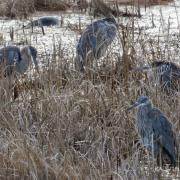Exploring Our School's Very Own Heronry
On October 9th, our Environmental Studies class at Nokomis Regional High was fortunate enough to have wildlife biologist, Danielle D’Auria, come to our class and talk to us about the Great Blue Heron nests that are located on our school grounds. We took a trip to the Heron Rookery right on our school property, where we were able to tag and measure 33 nesting trees and identify 39 heron nests.

Heron Tagged in Harpswell Surprises Biologists
For nine students at Harpswell Coastal Academy, Wednesdays in May meant donning knee-high boots, venturing to a nearby wetland, and hoping for signs a hungry great blue heron had been there. As part of a spring class elective, these students were dedicated to helping MDIFW ultimately tag a great blue heron with a GPS transmitter as part of an ongoing project to better understand heron habits in Maine.

Volunteers Contribute a Decade to Heron Monitoring
In what felt like a blink of an eye, we finished up our tenth year of monitoring great blue heron colonies with the help of Heron Observation Network volunteers. These citizen scientists often braved mosquitoes and black flies and hiked through thick swampy forests to get a good view of great blue heron nests, which were often in snags in the middle of a wetland, sometimes in what felt like the middle of nowhere.

How to Help an Injured Heron - Safely!
There is a small portion of our Great Blue Heron population that overwinters in Maine, but all those I have seen or heard about are juveniles. Quite often those that stay are not in great condition and may even be starving. A juvenile great blue heron captured accidentally by a beaver trapper this November was not injured in the process but was brought to Avian Haven - one of Maine’s top-notch bird rehabilitators - because it was noticeably thin.
Great Blue Heron is Newest Teacher at Easton Schools
On an otherwise quiet Sunday morning before dawn, our headlamps lit the way through cattails and boot-sucking mud as we carried a bucket of baitfish and tubs of traps to a bin set in the shallows of Christina Reservoir in Aroostook County.
Two Years Later, Two More Herons Tagged for Tracking
Two years after five of Maine’s great blue herons were outfitted with high-tech GPS transmitters, IFW once again worked closely with teachers and students from Nokomis Regional High School in Newport, Center Drive School in Orrington, and Haworth Academic Center in Bangor to re-deploy two of the tags on new herons.
Heron Observation Network's Ninth Year in a Nutshell
Volunteers are Vital From Eagle Lake to Milbridge to Eliot, the Heron Observation Network of Maine completed its ninth year of monitoring great blue heron colonies in an ongoing effort to better understand the status of the population. Great blue herons are widespread throughout Maine; however, a noticeable decline in their coastal nesting population has occurred since the 1980s.
Sedgey's Travels End, But Learning From Nature Continues
For those of you who have followed Sedgey’s travels over the last year and a half, he died on September 25th in North Carolina. Our research partner, John Brzorad from 1000 Herons, was able to locate and collect his remains to be examined by me and a few other biologists and veterinarians to determine the cause of death. The average lifespan of a great blue heron is 15 years.

Meet Our Most Highly Pursued High-Tech Wader: Snark
Have you heard about “Snark,” the first great blue heron in Maine to be outfitted with a GPS transmitter last spring, and the only one to be recaptured a year later? The great blue heron is a Species of Special Concern in Maine due to a decline along the coast.
Meet One of Our High-Tech Waders: Sedgey
Have you heard about “Sedgey,” one of five GPS-tagged great blue herons that IFW and students across Maine are tracking? Sedgey is a male tagged last spring on Sedgeunkedunk Stream in Orrington. He was named by the middle school students at Center Drive School, who helped biologists attract him to a trapping location.
Keep In Touch!
Enter your email or mobile number to receive the latest news from MDIFW.